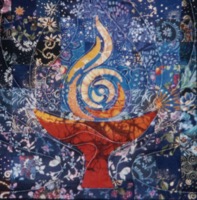Difference between revisions of "Chalice"
(Created page with "File:lighterstill.jpg ==Origin== [http://nordan.daynal.org/wiki/index.php?title=English#ca._1100-1500_.09THE_MIDDLE_ENGLISH_PERIOD Middle English]: via Old French from ...") |
m (Text replacement - "http://" to "https://") |
||
| (2 intermediate revisions by 2 users not shown) | |||
| Line 1: | Line 1: | ||
| − | [[File:lighterstill.jpg]] | + | [[File:lighterstill.jpg]][[File:Spiral_chalice.jpg|right|frame]] |
==Origin== | ==Origin== | ||
| − | [ | + | [https://nordan.daynal.org/wiki/index.php?title=English#ca._1100-1500_.09THE_MIDDLE_ENGLISH_PERIOD Middle English]: via Old French from [[Latin]] ''calix'' (mug), ''kalyx'' (shell, husk), ''calic''- ‘cup.’ |
| − | *[ | + | *[https://en.wikipedia.org/wiki/14th_century 14th Century] |
==Definitions== | ==Definitions== | ||
*1: a drinking cup : goblet; especially : the [[eucharist]]ic cup for drinking [[wine]]. | *1: a drinking cup : goblet; especially : the [[eucharist]]ic cup for drinking [[wine]]. | ||
*2: the cup-shaped interior of a flower | *2: the cup-shaped interior of a flower | ||
| + | |||
| + | |||
==Description== | ==Description== | ||
| − | In [[Christian]] [[tradition]] the Holy '''Chalice''' is the vessel which [[Jesus]] used at the [[Last Supper]] to serve the wine. [[New Testament]] texts make no mention of the cup except within the context of the Last Supper and give no significance whatever to the object itself. Herbert Thurston in the Catholic Encyclopedia 1908 concluded that "No reliable tradition has been preserved to us regarding the vessel used by [[Christ]] at the Last Supper. In the sixth and seventh centuries [[pilgrims]] to [[Jerusalem]] were led to believe that the actual chalice was still venerated in the [ | + | In [[Christian]] [[tradition]] the Holy '''Chalice''' is the vessel which [[Jesus]] used at the [[Last Supper]] to serve the wine. [[New Testament]] texts make no mention of the cup except within the context of the Last Supper and give no significance whatever to the object itself. Herbert Thurston in the Catholic Encyclopedia 1908 concluded that "No reliable tradition has been preserved to us regarding the vessel used by [[Christ]] at the Last Supper. In the sixth and seventh centuries [[pilgrims]] to [[Jerusalem]] were led to believe that the actual chalice was still venerated in the [https://en.wikipedia.org/wiki/Church_of_the_Holy_Sepulchre Church of the Holy Sepulchre], having within it the sponge which was presented to Jesus on Calvary." Several surviving standing cups of precious materials are identified in local traditions as the Chalice.[https://en.wikipedia.org/wiki/Chalice] |
[[Category: Religion]] | [[Category: Religion]] | ||
[[Category: Anthropology]] | [[Category: Anthropology]] | ||
Latest revision as of 23:40, 12 December 2020
Origin
Middle English: via Old French from Latin calix (mug), kalyx (shell, husk), calic- ‘cup.’
Definitions
- 1: a drinking cup : goblet; especially : the eucharistic cup for drinking wine.
- 2: the cup-shaped interior of a flower
Description
In Christian tradition the Holy Chalice is the vessel which Jesus used at the Last Supper to serve the wine. New Testament texts make no mention of the cup except within the context of the Last Supper and give no significance whatever to the object itself. Herbert Thurston in the Catholic Encyclopedia 1908 concluded that "No reliable tradition has been preserved to us regarding the vessel used by Christ at the Last Supper. In the sixth and seventh centuries pilgrims to Jerusalem were led to believe that the actual chalice was still venerated in the Church of the Holy Sepulchre, having within it the sponge which was presented to Jesus on Calvary." Several surviving standing cups of precious materials are identified in local traditions as the Chalice.[1]
